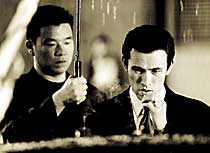When pitching the cinema of South Korea,
Sueyoung Park of the New York-based group Korean Film Forum is
apt to reach for common ground with Western movies.
Korean movies address "universal themes of love, friendship,
crime, violence, politics and gender [and] reflect technological
sophistication comparable to Hollywood films," she says.
From the point of view of Western cineastes, this accessibility
is a double-edged sword.
It’s true that in their storytelling technique, visual codes
and acting style, Korea’s movies feel more like America’s than
those of any other Asian film industry. Yet, looking at the precedents
of Hong Kong action flicks, Indian musicals or even the Japanese
classics, the fuel for cult status has been unfamiliarity – the
revelatory sensation of watching something from another world.
Despite its less flashy nature, contemporary Korean film has
earned plenty of attention the past few years, becoming a staple
of film festivals worldwide and enjoying success in Asia and
Europe and even an occasional release in the subtitle-allergic
United States. Now, Korean Film Forum has joined BAMcinematek
to help Brooklyn audiences play catch-up with a retrospective
of eight recent works Aug. 23-25. (The selection is culled from
the New York Korean Film Festival 2002, which runs Aug. 16-23
at Anthology Film Archives in Manhattan.)
Park credits the industry’s current success partially to "the
originality and quality of the films," but readily admits
to the importance of screen quotas introduced by the government
in the 1990s, requiring theaters to offer homegrown product at
least 106 days out of the year.
"It’s only been since 1999 that Korean cinema has been able
to stand on its own against Hollywood blockbusters," says
Park. "Back in 1988, when the import restriction on foreign
film was lifted and Korean films had to compete directly with
Hollywood and Hong Kong films, Korean films gradually lost their
market share to a low 16 percent by 1993."
By contrast, when the 2001 Korean box office was totaled, domestic
films had a nearly 50-percent share. In 1998, the government
had made noises about reducing the screen quota to 92 days. A
storm of protests by industry professionals, which saw some shaving
their heads and others marching with their own funeral portraits,
put that plan in the deep freeze.
"I’m certain the debate isn’t over, though," notes
Park, "as there are continuing pressures from the U.S. government
and theater owners to change or remove the system."
Writing by e-mail from South Korea, writer-director Yoon Jong-chan
scoffs, "The argument that a film industry ought not to
be protected by government mandates is the logic only of Hollywood
distributors. Why does a giant try to fight and compete with
a little boy? Of course, I don’t mean ’screen quotas’ will be
needed forever It’s a matter of time."
Yoon already has enough trouble creating the films he wants.
"It is very hard to make art-house films in Korea,"
he says, no doubt thinking of his 2001 feature debut, "Sorum,"
which opens the BAM series on Aug. 23. This is one of a recent
spate of Asian films (such as Korea’s "Memento Mori"
or Japan’s "Audition" and "Pulse") that can
be shoehorned into the "horror" slot but use the conventions
so obliquely that they barely qualify for the genre label.
"Sorum" concentrates on "the isolation and alienation
experienced by the socially and physically marginalized characters"
who happen to live in a ramshackle housing block cursed with
a haunted apartment, Park observes.
"Audiences who visited the theater with a box of popcorn
to watch a spooky horror movie were disappointed," Yoon
says. "From the beginning, I was not interested in a ’ghost
story.’ Rather, what I wanted to express was the fear and tragedy
resulting from the absurdity, stupidity and greed of human beings."
The film bears out Yoon’s claim, even while his words sell short
the clammy anxiety "Sorum" is capable of inducing in
a number of scenes.
Yoon disagrees with Park’s claims about originality. "Current
Korean films are very much commercial" and derivative, he
asserts. He makes a comparison to Hong Kong cinema, which gorged
on action crowd-pleasers during its heyday in the ’80s and early
’90s and then slumped badly.
"[This decline] is a warning for the future of the Korean
film industry," said Yoon. "In order to avoid repeating
the mistakes of Hong Kong cinema, a wide spectrum of films should
be produced."
Where one thinks Kwak Kyung-Taek’s "Friend" (screening
Aug. 24) fits into this picture depends one’s outlook. Last year,
the lavish crime melodrama sold almost twice the number of tickets
its nearest competitor did and stomped the country’s all-time
box office record.
"Friend" follows four childhood pals over 20 years
while two of them descend into underworld rivalry and bloodshed.
Supposedly autobiographical, it feels like a medley of elements
from Asian gangster movies and coming-of-age school stories,
as well as seminal American mob movies like "Mean Streets"
and "Once Upon a Time in America."
Park attributes the success of its themes of friendship and loyalty
to nostalgia for the ’70s and early ’80s childhood of the characters
and to its swooning visual poetry. (Korea may make the prettiest
films on earth right now.) Whatever the reasons, "Friend"
heralds an unprecedented power for domestic filmmaking, while
questions persist in some quarters about how healthy it is for
any one movie to dominate theaters.
The crime blockbuster of 2002 has so far been the far less lyrical
and sentimental "Public Enemy," (screening Aug. 23)
from Kang Woo-Suk, the director, producer and movie mogul widely
considered the industry’s most powerful individual. It’s certainly
the down-and-dirty work of a crowd-pleaser, with more noggin-smacking
than a Three Stooges feature, about three profanities per subtitle
and a scruffy detective protagonist so corrupt his own mother
nags, "Can’t tell if you’re a policeman or a gangster."
When his moral outrage is reawakened by a slick, yuppie psycho-killer,
the detective sets out to deliver vigilante-style justice with
which the audience is clearly expected to sympathize.
The festival’s cinematic perp walk also includes Ryu Seung-Wan’s
noir action yarn "No Blood, No Tears" (2001; screens
Aug. 25), a female twist on the one-big-heist sub-genre.
But the retrospective doesn’t neglect the independent filmmakers
whose more personal work first drew the attention of international
critics to Korea. Hong Sang-Soo received probably his widest
acclaim to date with the bitter romantic-sexual triangle "Virgin
Stripped Bare by Her Bachelors" (2000; screens Aug. 25).
The erotic title notwithstanding, this is an understated slice
of life rendered in clean black-and-white and long, still camera
takes. Despite this austere gaze, it is touching, witty and compassionate
in its portrayal of the disconnect between the genders and the
ways sex can warp relationships and male egos.
Park also makes particular note of first-time director Jeong
Jae-eun’s award-winning, female coming-of-age piece, "Take
Care of My Cat" (2001; screens Aug. 25). "She represents
a growing number of talented female directors in Korea to keep
watch on," he says.
Kim Dae-Seung’s "Bungee Jumping of Their Own" (2001;
screens Aug. 24) could be usefully noted here as a successful
hybrid of the indie and populist sensibilities. But by all means,
avoid reading the plot-spoiling synopsis in the official schedule.
The first act is a charming romance about a college odd couple.
So far, so cozy. But then comes a breathtaking, quasi-supernatural
twist, and the story blooms like some exotic flower into a wrenching
fable of regret and obsession.
Perhaps the hero could use a touch of the memory-erasing "oblivion
virus" in Moon Seung-Wook’s science fiction drama "The
Butterfly" (2001; screens Aug. 24), a low-budget, digital
video award-winner that also crossbreeds popular conventions
with the offbeat and personal.
So is the glass half empty or half full?
"It’s a very exciting time for the Korean film industry,"
says Park. "The government and the industry have recognized
this potential, and we’re seeing more investments being funneled
to the industry and we’ll probably see more growth as a result.
Kang Woo-Suk’s film academy is set to open in the fall to give
free education to five to 10 Korean students on all aspects of
filmmaking for the next five years."
In counterpoint, Yoon laments, "Compared to contemporary
Japanese or Chinese cinema, Korean cinema seems to have fallen
behind in maintaining its distinctive identity. The Korean film
industry looks like an overheated stock market – it is booming
now, but it’s in a very unstable situation and nobody knows when
capital will be withdrawn from it.
"What is really required to continue the vitality of the
industry," he says, "is talented people who have discerning
eyes."
Grateful acknowledgment is
made to Darcy’s Korean Film Page (www.koreanfilm.org) for research
assistance.
"New Korean Cinema" will run
Aug. 23 through Aug. 25 at BAMcinematek, 30 Lafayette Ave. at
Ashland Place. Tickets are $9, $6 seniors 65 and over, children
under 12. For movie times and information, visit www.bam.org
or www.koreanfilmforum.org
on the Web or call BAM at (718) 636-4100.

























